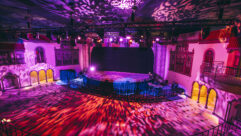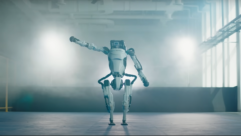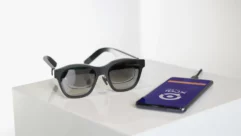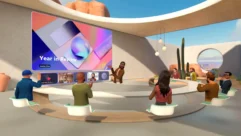

On November 15th nature and wildlife photographers from all over the world attended the Nature’s Best Photography Windland Smith Rice International Awards gala in the rotunda of the Smithsonian National Museum of Natural History in Washington D.C.
The event was a celebration of nature photography and the practitioners whose greatest joy involves spending hours, days, even weeks staking out the remotest locations in the world to capture the type of shots that grace the walls of museums and the pages of magazines such as Nature’s Best Photography and National Geographic — a massive herd of wildebeest crossing a river, a silver fox bonding with her cub or raging waterfall in those few moments when the light is almost otherworldly.
The ceremony itself was designed to transport the attendees – primarily photographers from 60 countries and their proud guests – far away from the damp, chilly city night just outside the building to the various environments the shooters captured in jungles and rain forests, on glaciers and far below ocean surfaces.
The key to creating this experience lay in the visual presentation based on the winning images. These transporting images were projected in their original form during the proceedings onto two large screens straddling the main stage. But they also filled the room in a different way—expressed in motion, through projection mapping, onto the rotunda’s ornate architecture. Powerful Epson laser projectors played a significant role in displaying these images with the color rendition, contrast and brightness necessary to meet the standard of the source content and the expectations of a discerning audience.
The requirements for the overall presentation were a bit unusual for a projection mapping event in that the imagery projected was representing world-class photography to the photographers themselves in the fact that the venue itself is virtually hallowed ground for the honorees, both for its work with photography and support for naturalists and conservationists. As the evening progressed, the photographers’ speeches indicated a devotion to the photographs they create, and an even greater passion for the animals and landscapes they capture in that work; they spoke more strongly about species and pristine locations that are in serious danger of extinction or destruction, than about the artistic elements of their own work. The projections were there to complement this passion, not to overpower it.
The subtle animations – say a pair of zebras’ heads slowly nodding and composited against a painterly animated backdrop, or a tight shot of an owl multiplied several-fold and augmented with whimsical and unlikely eye movements – would show up in various places in the rotunda as the awards ceremony progressed beneath. Firpo’s team kept it interesting by changing up exactly where and how large each segment would be: Some would take up nearly the entire wall above the stage; some would be much smaller. Throughout the run of the show, these same animations would play on small window-like portions of the overhead dome treating the confines of each as a “screen” unto itself. The Da-Lite screens and the so-called skylights essentially acted as prosceniums with imagery dissolving from one animation to the next. On the other hand, the largest images mapped to the walls were not confined that way; they were free to take up as much or as little space as the creatives decided and they’d mix it up to keep it interesting.
This projection portion of the evening, overseen by Nature’s Best Photography, was created by San Francisco-based experimental design company All of it Now. As content creator they took advantage of the capabilities of the Epson projectors and lenses, as well as utilizing new and powerful features of the disguise server and software that they used to create and playback the content. Eight of Epson’s 25,000 lumen Epson Pro L25000U supported the projection mapping. Two rear screen Epson Pro L20000U equipped with ultra short throw lenses supported the onstage imagery.
Legrand America’s Da-Lite custom screens, a number of Adobe creative applications, Maxon Cinema 4D brought everything together for the projections. AV specialists Nomad Event Systems oversaw the actual rigging of the projectors and screens in the complex space full of corners and architectural embellishment.
This was the second time All Of It Now had been tapped to create the content, following a positive reception to a similar show they created for last year’s event. “We are not center stage,” says the company’s CEO Danny Firpo (who shares the running of the company with President Howard Wong). “The photographers and the photographs are the primary focus.”

The centerpiece of the projections are the winning 60 images, selected by Nature’s Best from over 26,000 entries. The organization has strict policies about using very limited digital manipulation of images. The super wide-angle landscapes, extreme telephoto imagery of moose, owls and foxes and the rest, had to represent what was actually in front of the photographer’s camera, with the artistic influences being limited to the choice of lens, framing and specific moment to trip the shutter.
“We want these images to duplicate what they saw in the field,” explains Steve Freligh, awards director. “When we select a winner we have them send high resolution file and also raw files. Our job is to share the experience as close as we can to what the photographer saw in the field. You don’t add something. You don’t take something out. You can afford a little clarity to it but we want to keep it very simple and straightforward.”
The projections would naturally be of a lower resolution than the prints themselves which hang in a gallery in the same building, printed at a much higher resolution on professional Epson inkjet printers. And of course there would be inevitable imperfections in the color rendition when projected onto a nonwhite surface.
But All of it Now was charged with finding the technology to compensate to the greatest extent possible, in terms of color fidelity, contrast and resolution in playback, as well as content design that expressed both the intent of the images and adapted to the challenges of the projection surface. For example, the architecture in the Rotunda has a lot of protuberances and cervices and a lot of other things that create shadows. If there are shadows created by the surface, projector mounting can minimize it and then the disguise software compensates and adds brightness into those specific areas.
Firpo extends a lot of credit to the Epson laser projectors’ power in providing the contrast, color gamut and flexibility necessary— singling out the deeper blacks and more faithful reds. By using two projectors from different angles, the imagery can be presented so that obstructions in the projection surface, not cause shadows; where illumination from one angle would be shadowed, the identical image coming from another projector fills that shadow in, supported with the dynamic blending function of the server.
To create the content, Firpo’s artistic team imported raw files of each of the images and then set to work rotoscoping portions of the frames – say a zebra’s head or the full body of an owl — creating animations and then enhancing those with some additional incidental elements built out of stock material – video of water or various design patterns.
This work was done primarily in Adobe Photoshop and After Effects, with some additional tools, such as Twixter to change the speeds of some stock assets that were integrated into the animations. They also made use of a few other tools, such as Notch Builder to generate snow particles to enhance an animation of a penguin. “We want to make the audience feel they’re there with the photographer,” Firpo says.
Rather than simply creating one long animation, All of It Now built a roughly 20-minute timeline made up of specific moments triggerable by an operator during the show, using an app designed by All of it Now’s Wong. Random access to the individual clips was necessary to ensure that the right animations played during the correct introduction or acceptance speech. The final resolution for the video assets was 2200 x 1728 achieved by using the 25,000 lumen projectors in pairs so that each one is projecting at 1100 x 864; together creating 50,000 lumens and the 2200 by 1728 resolution.
All of it Now made extensive use of disguise GX4 server, which they preferred among the company’s options, “because it gives us a lot of GPU firepower,” Firpo enthuses.
Preparing the animations for projection mapping onto the Rotunda’s walls, with their ornate architectural features, was a complex, iterative process. As with all projection mapping, the essential idea is to build a model in 3D space of the exact dimensions of the surface being projected onto and then displacing the images themselves such that everything curved or bumpy or raised or recessed in any way – any feature that would distort a normally-projected picture — is factored in and the image is distorted such that it exactly compensates for the unevenness or lack of flatness of the surface. Project on a dome such as the one atop the Rotunda, for example, and the server uses the model of the venue to counters the distortion; likewise for the walls.
The effect, of course, is only as successful as that 3D model and All of it Now took great pains to get as much detail as possible into the model. The disguise server and that company’s new Omnial system would allow for finetuning once they were inside the space, but they’d have almost no time to make adjustments between load-in and the show.
“The great thing about disguise,” Firpo explains, “is that it allows us to make use of a 3D workflow throughout the process, instead of a 2D workflow so we can simulate the entire presentation from viewer positions in 3D space long before actually getting to venue.” By using OmniCal to review the creative work, the team and clients were able to see the entire projection mapping show come together in a virtual version of the venue, which is always important, Firpo elaborates, because imagery that are very pleasing in their studio projected in a 2D monitor might play very differently.
“We have to be sensitive with projection mapping about how it translates from the computer screen,” Firpo adds. “Going from three to four feet wide, that becomes 20 or 25 feet or more. What appears to be small minor motion on computer screen would seem to move considerably faster in the larger space. We love the VR visualizer inside disguise because we can put on VR goggles and preview the [show] from every position on the ‘floor’ months before we actually load in. That let us previsualize and refine color, editing, resolve smooth transitions for the environments.”
From 10AM to 3PM the day before the event, members of Firpo’s team were finally able to get inside the Rotunda to refine their working model of the space by taking over 400 standard photographs of the space and importing those into Autodesk Reality Capture on a laptop. Reality Capture is photogrammetry software that uses structured light to create a 3D mesh based on these photographs. Then the group used OmniCal to take that mesh and deform to match the projectors’ perspective. OmniCal can also essentially simultaneously calibrate all the projectors, sparing the team a painstaking one-at-a-time rush to doors open.
The evening’s other projection element marked the US debut of Epson’s 20,000 lumen Epson Pro L20000U laser projectors (available in 2019). Two of these projectors were positioned as rear projection systems to display the animations on flat screens on either side of the stage. The screens—Da-Lite’s Dual Vision line—make use of vinyl which is coated on both sides with the company’s proprietary surface technology to allow users the options of using them for either front- or rear-projection applications. The very short throw of only a few feet might previously have created difficulties in terms of focus and optical distortions, but Epson’s new ELPXO2.

Ultra Short Throw Lenses enable independent control of corners and the center – necessary to get ideal quality in challenging situations where the projector must be unusually close to the screen.
To this observer the projected elements really did enhance the event almost subliminally. Without ever declaring itself it offered a powerful yet elegant supplement to the excitement and passion that the photographers have for their work. Had the content been more aggressive or had the execution not been so seamless, the overall effect would only have subtracted from the event itself. The fact that the animations were as subtle and abstract as they were and that they really did match the tone of the winning photographs rendered the entire projection portion of the evening a presence that underlined the meaning of the event – precisely what Nature’s Best was after.
“The movement gives you a sense of being there,” said Awards Director Steve Freligh immediately after the event. “The screens on either side combined with the projections on the dome and the skylights above the stage — of all of it together brought still life to real life.”










